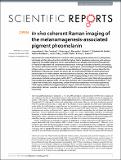In vivo coherent Raman imaging of the melanomagenesis-associated pigment pheomelanin
Author(s)
Wang, Hequn; Igras, Vivien; Roider, Elisabeth M.; Pruessner, Joachim; Fisher, David E.; Evans, Conor L.; Osseiran, Sam; Nichols, Alexander J.; Tsao, Hensin; ... Show more Show less
DownloadIn vivo coherent.pdf (1.521Mb)
PUBLISHER_CC
Publisher with Creative Commons License
Creative Commons Attribution
Terms of use
Metadata
Show full item recordAbstract
Melanoma is the most deadly form of skin cancer with a yearly global incidence over 232,000 patients. Individuals with fair skin and red hair exhibit the highest risk for developing melanoma, with evidence suggesting the red/blond pigment known as pheomelanin may elevate melanoma risk through both UV radiation-dependent and -independent mechanisms. Although the ability to identify, characterize, and monitor pheomelanin within skin is vital for improving our understanding of the underlying biology of these lesions, no tools exist for real-time, in vivo detection of the pigment. Here we show that the distribution of pheomelanin in cells and tissues can be visually characterized non-destructively and noninvasively in vivo with coherent anti-Stokes Raman scattering (CARS) microscopy, a label-free vibrational imaging technique. We validated our CARS imaging strategy in vitro to in vivo with synthetic pheomelanin, isolated melanocytes, and the Mc1re/e, red-haired mouse model. Nests of pheomelanotic melanocytes were observed in the red-haired animals, but not in the genetically matched Mc1re/e; Tyrc/c (“albino-red-haired”) mice. Importantly, samples from human amelanotic melanomas subjected to CARS imaging exhibited strong pheomelanotic signals. This is the first time, to our knowledge, that pheomelanin has been visualized and spatially localized in melanocytes, skin, and human amelanotic melanomas.
Date issued
2016-11Department
Harvard University--MIT Division of Health Sciences and TechnologyJournal
Scientific Reports
Publisher
Nature Publishing Group
Citation
Wang, Hequn, Sam Osseiran, Vivien Igras, Alexander J. Nichols, Elisabeth M. Roider, Joachim Pruessner, Hensin Tsao, David E. Fisher, and Conor L. Evans. “In Vivo Coherent Raman Imaging of the Melanomagenesis-Associated Pigment Pheomelanin.” Scientific Reports 6, no. 1 (November 28, 2016).
Version: Final published version
ISSN
2045-2322